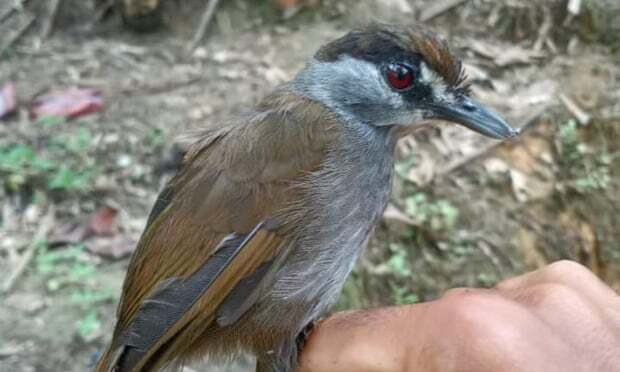
Black-browed Babbler © M. Suranto
Stories about rediscoveries of ‘lost’ species make for exciting ornithological news, and recently, several reports from Asia have caught special attention.
One of these was the rediscovery of Cebu Flowerpecker (Dicaeum quadricolor) by Rob Timmins and others on the Philippine island of Cebu (Dutson et al. 1993). It had not been seen by any ornithologists for 86 years and was considered extinct in the wild, especially because very little forest remained on the island. Its rediscovery was an extraordinary event in 1992.
Another remarkable event came when Phil Round and co-workers were on a ringing (bird banding) campaign in Laem Phak Bia, southwest of Bangkok, Thailand, and a Large-billed Reed Warbler (Acrocephalus orinus) entered the net on 27 March 2006 (Round et al 2007). It was a species known only from a single specimen collected in November 1867 in the Sutlej Valley, Rampur, Himachal Pradesh, northern India, which was deposited as a skin at the Natural History Museum, Tring (NMH). Having been unknown in the field for 139 years, initial debate centered on the validity of the species, but it was eventually found to be Acrocephalus orinus. The species has since been observed in the wild and its breeding grounds located; they extend from SE Kazakhstan to NE Afghanistan, through Tajikistan and parts of E Uzbekistan and Kyrgyzstan, in mountainous areas at 900–3000 m (Dyrcz et al 2020).
All the previous cases, however, are obscured by the magnitude of the present discovery, published just this week (Akbar et al. 2020). Black-browed Babbler (Turdinus perspicillatus) was rediscovered in the field in October 2020 by two local men, Muhammad Suranto and Muhammad Rizky Fauzan, in South Kalimantan, Borneo. Suranto and Fauzan managed to capture and photograph the bird before releasing it. After circulating the pictures, it was confirmed as one of the biggest rediscoveries of the century: a species known from a single original specimen procured between 1843 and 1848, a species “lost” for 170 years, had been rediscovered in the wild.
Black-browed Babbler has captivated scientific imagination for years. Nigel Collar (2014) contemplated where the type specimen came from and whether the species could still be surviving. The specimen label says only ‘Java’ with no other details, apparently because Charles Lucien Bonaparte, the nephew of Napoleon, described it to science and named it as Malacocincla perspicillata, and mistakenly presumed the provenance was the island of Java. However, its collector, the German geologist Carl Anton Ludwing Maria Schwaner, was only known to have explored in Borneo (1843-1848).
Mees (1995) argued that Schwaner collected mainly around Martapoera in south Kalimantan province on Borneo, suggesting that ‘it may safely be assumed that M. perspicillata is a lowland bird, and it is likely that it is from the neighborhood of Martapoera’. The assumption by Mees regarding its geographic origin is demonstrably correct, since the rediscovery was made in South Kalimantan, Borneo.
Birds known from a single specimen, for which no other evidence of their existence can be found, present scientists with a bit of a taxonomic quandary: does the bird represent a “real” species, or is it a hybrid or aberrant plumage of another? The newly discovered Black-browed Babbler presents several diagnostic characters–a strong bill, black forehead, supercilium and preocular spot, whitish lores, sharp eye-ring, and gray underparts with deep rust flanks–providing strong evidence it is a full species.
As we learn more about the babbler and the excitement of its rediscovery ebbs, the bird’s present conservation status will come into view. Likely it is a species with a restricted range and hence a delicate global situation. The authors of the present note (Akbar et al 2020) mention that they are working on a detailed manuscript documenting the discovery, where they will probably advance some information regarding its hypothetical conservation status and threats for the species on the region where it has been rediscovered.
As we commented in a previous blog, Indonesia is a land of spectacular biodiversity, likely to harbor more undiscovered species and others, like the Black-browed Babbler, to be “resurrected” from extinction.
References
Akbar, P.G., T.W. Nugroho, M. Suranto, M.R. Fauzan, D. Ferdiansyah, J.S. Trisiyanto, and D.L. Yong (2020). Missing for 170 years—the rediscovery of Black-browed Babbler Malacocincla perspicillata on Borneo. BirdingASIA 34: 13-14.
Collar, N.J. (2014). Blue-wattled Bulbul Pycnonotus nieuwenhuisii and Black-browed Babbler Malacocincla perspicillata: two Sundaic passerines in search of a life. BirdingASIA 21: 37-44.
Dutson, G. C. L., P.M. Magsalay, and R.J. Timmins (1993). The rediscovery of the Cebu Flowerpecker Dicaeum quadricolor, with notes on other forest birds on Cebu, Philippines. Bird Conservation International 3: 235-243.
Dyrcz, A., E. de Juana, and G. M. Kirwan (2020). Large-billed Reed Warbler (Acrocephalus orinus), version 1.0. In Birds of the World (J. del Hoyo, A. Elliott, J. Sargatal, D. A. Christie, and E. de Juana, Editors). Cornell Lab of Ornithology, Ithaca, NY, USA. https://doi.org/10.2173/bow.labrew1.01
Mees, G. F. (1995). On Malacocincla vanderbilti de Schauensee & Ripley, and Malacocincla perspicillata (Bonaparte) (Aves, Timaliidae). Proc. Kon. Ned. Akad. Wetensch. 98: 63–68.
Round, P.D., B. Hansson, D.J. Pearson, P.R. Kennerley, and S. Bensch (2007). Lost and found: the enigmatic Large-billed Reed Warbler Acrocephalus orinus rediscovered after 139 years. Journal of Avian Biology 38: 133–138.

Partnerships
A global alliance of nature organizations working to document the natural history of all bird species at an unprecedented scale.
















